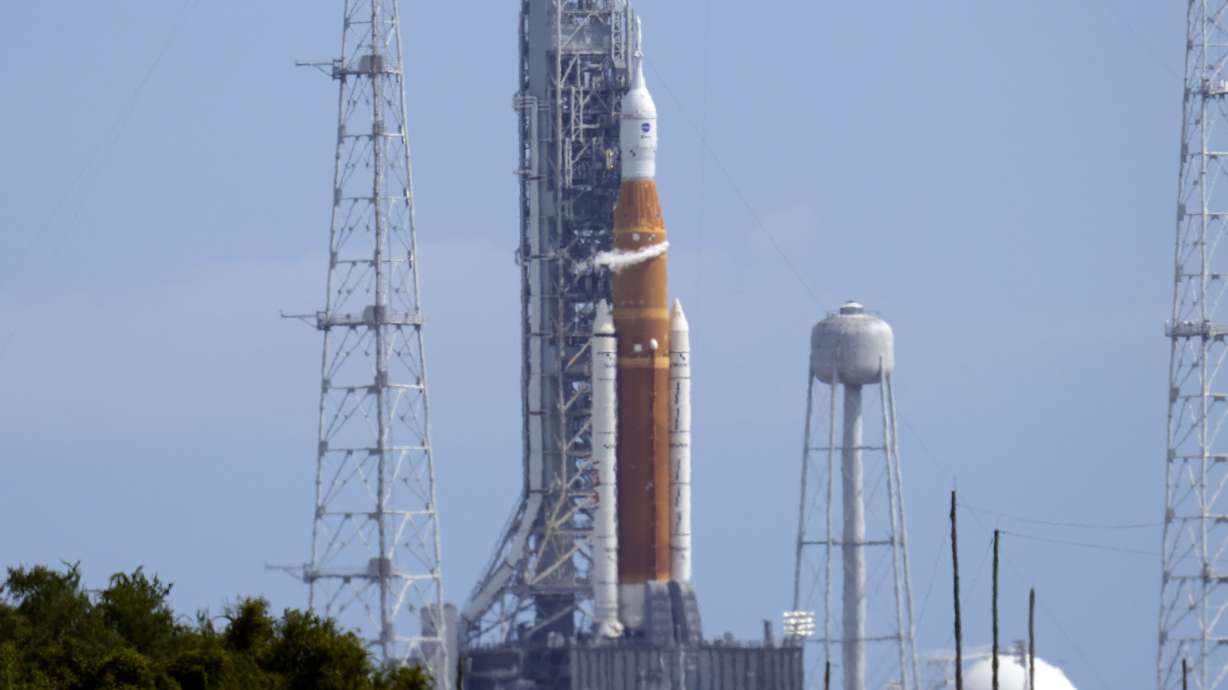Estimated read time: 3-4 minutes
This archived news story is available only for your personal, non-commercial use. Information in the story may be outdated or superseded by additional information. Reading or replaying the story in its archived form does not constitute a republication of the story.
CAPE CANAVERAL, Fla. — For the second time in a week, NASA's attempt to launch the Artemis I space mission was scrubbed, this time due to a leak in the liquid hydrogen fueling process that could not be solved in time to make the two-hour launch window that was set to open at 2:17 EDT.
NASA reports the leak was detected around 7 a.m. EDT during the pre-launch fueling process and three attempts to address the issue were unsuccessful. Artemis I launch director Charlie Blackwell-Thompson declared a scrub just after 11 a.m. EDT.
Monday's launch attempt was scrubbed after compounding issues arose during a process to prep the engines on the new, massive Space Launch System.
Following the Monday scrub, NASA Administrator Bill Nelson noted that launch delays and resets are a normal part of the massive coordination and preparation that are part of every space mission.
"When you're dealing with a high-risk business, and space flight is risky, that's what you do," Nelson said. "You buy down that risk. And of course, that is the whole reason for this test flight ... to stress it and to test it to make sure it's as safe as possible."
The crewless Artemis I mission is scheduled to run for 42 days on a flight that will allow NASA experts to test the new SLS components, many of which have been repurposed from the old space shuttle program and other systems, as well as the Orion space capsule.
That capsule, the eventual home for future space travelers, will be carried into lunar orbit where it will take a spin around the moon and then head back to earth for a fiery plunge through the atmosphere at some 25,000 mph before splashing down in the Pacific Ocean at the end of the mission.
Artemis I is just the first in a three-phase program aiming to put astronauts back on the surface of the moon for the first time since the final Apollo moon visit in December 1972.
Artemis II, currently anticipated for some time in 2024, will head to space with a four-person crew in the Orion capsule that will fly the craft around the moon in further testing. Then, if all goes according to NASA's current plan, the SLS/Orion package will return on a mission that will include a landing on the moon's surface in 2025. Along the way, NASA wants to put a small space station, the Lunar Gateway, in orbit around the moon and has future plans that include a moon base station, the Artemis Base Camp.
So, why go back to the moon?
In a posting on the Artemis missions' website, NASA lists a few reasons why it's devoting billions of dollars to making moon landings, once again, a priority.
"We're going back to the moon for scientific discovery, economic benefits and inspiration for a new generation of explorers: the Artemis Generation," NASA says. "While maintaining American leadership in exploration, we will build a global alliance and explore deep space for the benefit of all."
And while a return to the moon smacks a little of "been there, done that," NASA says it's committed to accomplishing some other first benchmarks as part of the series of Artemis missions, including extending manned exploration deeper into the solar system.
"With Artemis missions, NASA will land the first woman and first person of color on the moon, using innovative technologies to explore more of the lunar surface than ever before," NASA says in a web posting. "We will collaborate with commercial and international partners and establish the first long-term presence on the moon. Then, we will use what we learn on and around the moon to take the next giant leap: sending the first astronauts to Mars."
NASA says its SLS launch system stands at 322 feet high — taller than the Statue of Liberty — and weighs 5.75 million pounds when loaded with fuel. During launch and ascent, the SLS will produce 8.8 million pounds of maximum thrust, 15% more thrust than the Saturn V rockets that propelled Apollo astronauts to the moon.









